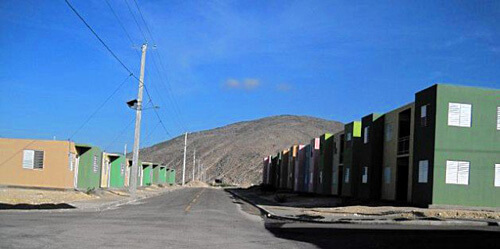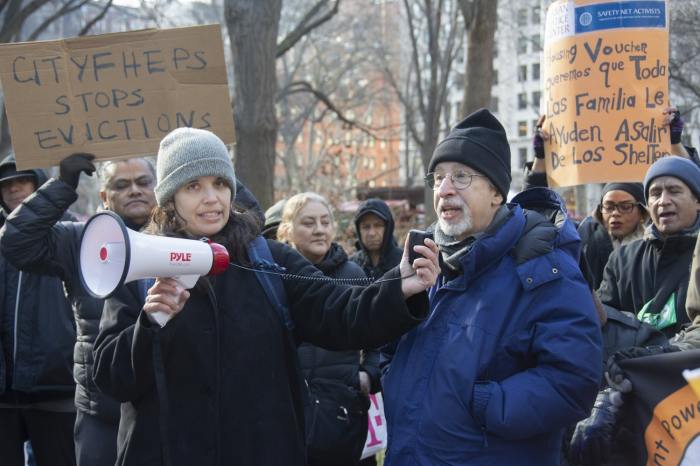PORT-AU-PRINCE, Jan 20, 2014 (Haiti Grassroots Watch) – Named after a famous Haitian singer, the Lumane Casimir Village sits in the desert-like plain at the foot of Morne à Cabri and will eventually have 3,000 rental units. About 1,300 are now ready.
The project was financed with 49 million dollars from the Petro-Caribe Fund, money that will eventually have to be paid back to the Venezuelan government.
During the May 16, 2013 inauguration, the president handed out keys to a group of families that had been assembled for the media. But they did not move in. From May to September, nobody actually lived in the apartments. Families only moved in starting in October. In the meantime, many were looted.
“Between 120 and 150 apartments were vandalised,” explained David Odnell of the Unit for the Construction of Housing and Public Buildings (UCLBP), one of three government agencies involved with housing. UCLBP is the supervisor of the site.
More than 50 toilets, and dozens of locks, windows, brackets, bulbs, electrical cables and outlets were stolen. Many apartments were also damaged by would-be thieves who used crowbars and other tools to try to wrench sinks, doors and windows from walls.
“The thieves still come,” Bélair Paulin told Haiti Grassroots Watch (HGW). Paulin spends a lot of time in the area because he is waiting to see if he will be chosen as a renter.
About 200 families have already moved in and others have their keys. Some 1,100 homes remain empty.
During a visit to the site on Dec. 20, 2013, Martelly announced that 250 police officers will be getting apartments and handed over keys to 75 of them, again, in front of the cameras. Several later denounced the fact that they were asked to hand the keys back after the ceremony.
All of the apartments have water and electric systems, new trash cans, a gas stove, a container for receiving and purifying drinking water, plants growing in a garden which will benefit from a regular watering service, and the promise of round-trip transportation to the capital for 20 gourdes (about 50 cents).
Under the heavy sun, the sounds of the new residents echo though the site. Voices, doors opening and closing, cars coming and going. The village is coming to life.
According to Odnell, eventually the village will have “a waste disposal system, a police station, a health center, a drinking water reservoir, a public square, a soccer field, a connection with the electricity system, a vocational school, an elementary school and a marketplace.”
The government is also building an industrial park across the street, where – authorities hope – residents can work.
“The mini-industrial park will have all the facilities necessary to create local jobs for housing beneficiaries,” Odnell promised, noting that a Canadian company has already expressed interest.
The park is not yet finished and – as of late 2013 – has not yet been registered as a “free trade zone” industrial park.
Like other projects, the new residents of Lumane Casimir Village are not necessarily earthquake victims. (Read Part One)
“There are three criteria for being eligible: 1) You have to have been affected by the earthquake, 2) the person has to have a family of not more than three to five people, and 3) the person must have a revenue. That is the most important, so you can pay your rent, which will be between 163 and 233 dollars per month,” according to Odnell.
Christela Blaise is one of the new renters. A cosmetician, she has lived at the village with her older sister and baby since October.
“After the earthquake, we lived in Bon Repos on the main highway. We were not direct victims of the earthquake, but like everyone who was looking for a place to live, we got a temporary shelter. But that didn’t last past three months, so we moved back to our home,” she said.
Housing: An immense challenge
The Haitian government recognises that it faces an enormous challenge. Some 150,000 earthquake victims still live in about 300 camps and another 50,000 live in the new sprawling slums Canaan, Onaville and Jerusalem.
Half of the camps have no sanitation services and only eight percent are supplied with water, according to an October 2013 report from the UCLBP and the Camp Coordination and Camp Management (CCCM)/Shelter Cluster, part of the U.N.’s humanitarian presence in Haiti.
Residents of over 100 camps are in imminent danger of being evicted. In December, 126 families were forced to leave their homes and shacks in Canaan, near Village Lumane Casimir, and on Jan. 11, a camp in Delmas was consumed in flames. One woman and three young children were burned to death.
According to the government, the housing deficit will only continue to grow as people leave the countryside and smaller towns and move to cities.
“Haiti needs to meet the challenge of constructing 500,000 new homes in order to meet the current and housing deficit between now and 2020,” according to the UCLBP’s new Policy of Housing and Urban Planning (PNLH), released in October.
The new policy is ambitious but vague. The Executive Summary sketches out five “strategic axes” that will help “grow access to housing,” including “social housing” that meets construction norms, and through the promotion of “models of housing that assure access to basic services.”
The language of the document implies that the government will seek to resolve the deficit in partnership with the private sector. In the introduction to the PNLH, for example, Prime Minister Laurent Lamothe notes that “under the coordination of the UCLBP, the PNLH also makes clear the important role that the private sector is being called upon to play, side-by-side with the state.”
While this kind of orientation should not necessarily be rejected out of hand, already with the Lumane Casimir Village and the 400% and Chavez Houses projects, it appears that the government is no longer going to build social housing that is within reach of the majority of Haitians.
According to the World Bank, 80 percent of the population lives on less than two dollars per day. Even if a couple combines incomes, it would have only about 60 dollars a month. How could that family pay rent that runs from 39 dollars all the way up to 233 dollars per month?
Speaking at an event at the Lumane Casimir Village on Nov. 11, 2013, Lamothe affirmed his pride in the project, which he called “social housing.”
But, if the housing is not for the poor – such as, for example, the majority of the earthquake victims – and if, with monthly rents that reach 233 dollars, it is out of reach of 80 percent of the population, is it really correct to call it “social” or public housing?
Haiti Grassroots Watch is a partnership of AlterPresse, the Society of the Animation of Social Communication (SAKS), the Network of Women Community Radio Broadcasters (REFRAKA), community radio stations from the Association of Haitian Community Media and students from the Journalism Laboratory at the State University of Haiti.

























